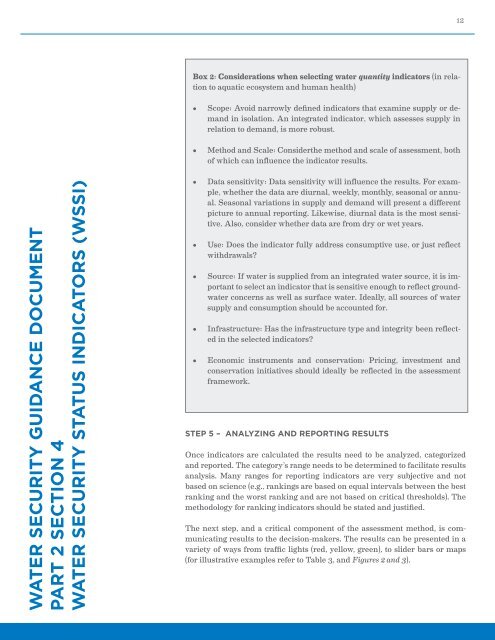Water Security Status Indicators - Program on Water Governance
Water Security Status Indicators - Program on Water Governance
Water Security Status Indicators - Program on Water Governance
Create successful ePaper yourself
Turn your PDF publications into a flip-book with our unique Google optimized e-Paper software.
WATER SECURITY GUIDANCE DOCUMENT<br />
PART 2 SECTION 4<br />
WATER SECURITY STATUS INDICATORS (WSSI)<br />
Box 2: C<strong>on</strong>siderati<strong>on</strong>s when selecting water quantity indicators (in relati<strong>on</strong><br />
to aquatic ecosystem and human health)<br />
• Scope: Avoid narrowly defined indicators that examine supply or demand<br />
in isolati<strong>on</strong>. An integrated indicator, which assesses supply in<br />
relati<strong>on</strong> to demand, is more robust.<br />
• Method and Scale: C<strong>on</strong>siderthe method and scale of assessment, both<br />
of which can influence the indicator results.<br />
• Data sensitivity: Data sensitivity will influence the results. For example,<br />
whether the data are diurnal, weekly, m<strong>on</strong>thly, seas<strong>on</strong>al or annual.<br />
Seas<strong>on</strong>al variati<strong>on</strong>s in supply and demand will present a different<br />
picture to annual reporting. Likewise, diurnal data is the most sensitive.<br />
Also, c<strong>on</strong>sider whether data are from dry or wet years.<br />
• Use: Does the indicator fully address c<strong>on</strong>sumptive use, or just reflect<br />
withdrawals?<br />
• Source: If water is supplied from an integrated water source, it is important<br />
to select an indicator that is sensitive enough to reflect groundwater<br />
c<strong>on</strong>cerns as well as surface water. Ideally, all sources of water<br />
supply and c<strong>on</strong>sumpti<strong>on</strong> should be accounted for.<br />
• Infrastructure: Has the infrastructure type and integrity been reflected<br />
in the selected indicators?<br />
• Ec<strong>on</strong>omic instruments and c<strong>on</strong>servati<strong>on</strong>: Pricing, investment and<br />
c<strong>on</strong>servati<strong>on</strong> initiatives should ideally be reflected in the assessment<br />
framework.<br />
STEP 5 – ANALYzING AND REPORTING RESULTS<br />
Once indicators are calculated the results need to be analyzed, categorized<br />
and reported. The category’s range needs to be determined to facilitate results<br />
analysis. Many ranges for reporting indicators are very subjective and not<br />
based <strong>on</strong> science (e.g., rankings are based <strong>on</strong> equal intervals between the best<br />
ranking and the worst ranking and are not based <strong>on</strong> critical thresholds). The<br />
methodology for ranking indicators should be stated and justified.<br />
The next step, and a critical comp<strong>on</strong>ent of the assessment method, is communicating<br />
results to the decisi<strong>on</strong>-makers. The results can be presented in a<br />
variety of ways from traffic lights (red, yellow, green), to slider bars or maps<br />
(for illustrative examples refer to Table 3, and Figures 2 and 3).<br />
12







